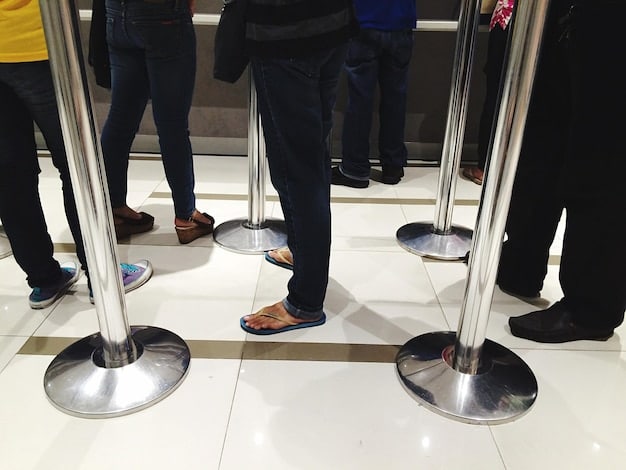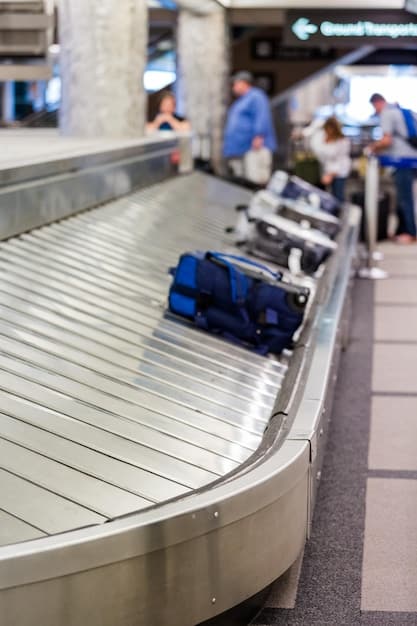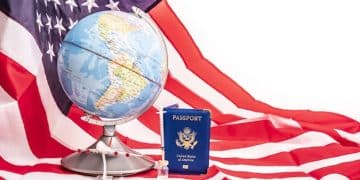Airport Security: Tips & Tricks for a Smooth Travel Experience

Navigating airport security efficiently involves understanding regulations, preparing belongings correctly, dressing appropriately, and staying informed, ensuring a smoother and less stressful travel experience.
Airport security can often be a stressful part of traveling. This ultimate guide to airport security: tips and tricks for a smooth experience aims to equip you with the knowledge and strategies to navigate the process with ease, turning a potential headache into a seamless part of your journey.
Understanding Airport Security Procedures
Airport security procedures are in place to ensure the safety of all travelers. Knowing what to expect can significantly reduce stress and make the process smoother. Here’s a glimpse into the standard procedures you’ll encounter at most U.S. airports.
TSA PreCheck vs. Global Entry
Understanding the differences between TSA PreCheck and Global Entry can save you time and hassle. TSA PreCheck expedites domestic security screenings, while Global Entry includes TSA PreCheck benefits and also speeds up customs processing when entering the United States from abroad.
- TSA PreCheck: Allows expedited screening at U.S. airports.
- Global Entry: Includes TSA PreCheck benefits and speeds up customs for international travel.
- Application Process: Both programs require an application, background check, and in-person interview in most cases.
- Cost and Renewal: Each program has its own fee structure and renewal timeline.

The security process typically involves several steps, beginning with document verification by a Transportation Security Administration (TSA) officer, who will check your identification and boarding pass. Next, you’ll proceed to the baggage screening area, where you’ll need to remove certain items and place them in bins for X-ray scanning. Finally, you will go through a physical screening.
Commonly, physical screening involves walking through a metal detector or body scanner. If anomalies are detected, a TSA officer may conduct a pat-down. Remember to remove metallic items, such as belts and jewelry, to expedite this step.
Understanding airport security procedures not only prepares you for the process but also helps you comply with regulations. Familiarize yourself with TSA guidelines for what you can and cannot bring in your carry-on luggage and checked baggage to avoid unnecessary delays at the security checkpoint.
Packing Smart for Airport Security
Packing strategically can significantly decrease the time spent at security. Understanding TSA’s rules and regulations regarding what you can and cannot bring on your flight is incredibly useful when deciding what to pack. Being prepared can reduce stress for everyone.
Liquids Rule: 3-1-1
The 3-1-1 liquids rule can be confusing, but it’s important to know. All liquids must be in travel-sized containers (3.4 ounces or less), and all containers must fit into one quart-sized, clear, plastic zip-top bag.
- Size Matters: Each liquid container should be 3.4 ounces (100 milliliters) or less.
- One Bag Only: All liquid containers must fit into one quart-sized, clear plastic bag.
- Remove at Security: Take the bag out of your carry-on bag and place it in a bin for X-ray screening.
Keep electronics accessible so you don’t have to dig through your bags at security checkpoints. Place larger electronic devices, such as laptops and tablets, in an easily accessible location for quick removal. Usually, these items need to be taken out of your bag and placed in a separate bin for X-ray screening.
Knowing how to pack smartly reduces the chances of delays or additional screening at airport security. Stay ahead of any possible setbacks by packing as strategically as possible. Consider separating items, checking your bags, and being ready for anything.
What to Wear for Expedited Screening
Your clothing choices can significantly impact the ease of your airport security experience. Selecting the right attire not only ensures comfort during your travels but can also help you move through the security process more quickly.
Choosing the Right Clothes
Avoid wearing clothing with excessive metal embellishments, such as large buckles, metal buttons, or underwire bras, as these can set off metal detectors. Opt for simple and comfortable clothing that will also make security checks easier.
Wear easy-to-remove shoes. Footwear is another consideration. Choose shoes that can be easily slipped on and off, as you’ll likely be asked to remove them for screening. Sandals, slip-ons, or other types of shoes without laces can greatly expedite the process.

Minimize accessories. Reducing the amount of jewelry and accessories that you wear to the airport can also speed up screening. Jewelry, watches, and belts with metal buckles should be removed and placed in a bin, which can cause delays if you’re wearing too many accessories.
Preparing your outfit for security as carefully as you prepare your bags can significantly reduce the time spent at the checkpoint. Always dress practically to minimize hassle.
Navigating Security with Special Items
Traveling with specific items requires additional planning and awareness of airport security rules. Knowing how to handle these situations can prevent delays and keep you in compliance with regulations. Whether it’s medical supplies, baby items, or sports equipment, each category has its own considerations.
Medical Supplies and Equipment
If you’re traveling with medications, inform TSA officers. Medications in liquid form exceeding 3.4 ounces are allowed but should be declared to a TSA officer. It’s also advisable to keep medications in their original, labeled containers to avoid confusion.
- Notify TSA: Let TSA officers know about any medical supplies or equipment you may have.
- Carry Documentation: Bring documentation from your doctor explaining medical needs.
- Label Medications: Keep medications in their original, labeled containers to avoid confusion.
Traveling with children typically means bringing items like breast milk and formula. These are exempt from the 3-1-1 rule, but you must declare them to TSA officers for additional screening. Be prepared for these items to undergo further inspection, and allow more time when going through security.
Traveling with sporting goods or musical instruments may present unique challenges at airport security. Check with your airline regarding any requirements for special handling.
How to Handle Common Airport Security Issues
Even with careful preparation, unexpected issues can arise at airport security. Being ready to resolve these situations can keep you calm and prevent further delays. Delays, pat-downs, and document problems are common issues you may encounter.
Dealing with Delays
Flight delays are common, so knowing what to do can help. Remain calm and courteous. If you encounter delays, stay calm and treat TSA officers with respect. A positive attitude can greatly improve the situation. Seek clarification if needed. Do not hesitate to politely ask TSA officers for clarification regarding any concerns or questions you may have.
If you’re selected for a pat-down, understand your rights. Pat-downs are conducted by TSA officers of the same gender. You have the right to request a private screening room. If you have any concerns during a pat-down, you have the right to speak with a supervisor.
It’s essential to verify that your government-issued ID has not expired and that the name on your ticket matches the name on your ID. If you encounter documentation problems, seek assistance immediately. If there is a discrepancy or problem with your ticket, contact airline staff promptly to resolve the issue.
Staying Informed and Updated on Regulations
Staying informed about current airport security guidelines is essential for a smooth travel experience. Security measures and regulations evolve, so it’s beneficial to stay updated on any changes that might affect your plans. You can stay up-to-date via TSA official channels and airline communications.
Checking TSA Guidelines
The Transportation Security Administration (TSA) maintains an official website with detailed information about current security regulations, prohibited items, and travel tips. Checking the TSA website before your trip can help you stay informed.
Many airlines provide pre-flight communications, such as emails or text messages, containing essential travel information, including reminders about current security measures. Keep an eye on airline communications for last-minute updates.
Airports and security protocols are subject to modifications. Keeping up with these changes guarantees that your trip meets present standards. Staying up-to-date with any new regulations to avoid delays or difficulties at security checkpoints guarantees ease during your journey.
| Key Point | Brief Description |
|---|---|
| ✈️ TSA PreCheck/Global Entry | Consider enrolling in these programs for expedited screening and customs processes. |
| 🧴 3-1-1 Liquids Rule | Adhere to the 3.4 oz liquid limit in a quart-sized bag to avoid delays. |
| 👗 What to Wear | Choose clothing and shoes that are easy to remove and free of excessive metal. |
| ℹ️ Stay Informed | Keep updated with the latest TSA guidelines and airline communications for any changing protocols. |
Frequently Asked Questions
▼
TSA PreCheck is a program that allows expedited screening at U.S. airports. Enrolling in TSA PreCheck can save you time by letting you go through security lines faster without removing shoes, laptops, liquids, belts, and light jackets.
▼
The TSA 3-1-1 liquids rule states you must place liquids in travel-sized containers (3.4 ounces or less) and all containers must fit into one quart-sized, clear, plastic zip-top bag. You must remove the bag from your carry-on and place it in a bin for X-ray screening.
▼
Yes, you can generally bring food through airport security, but there are some restrictions. Solid food items are typically allowed in both carry-on and checked baggage. However, liquid or gel-like foods are subject to the 3-1-1 liquids rule.
▼
If the metal detector goes off, you may be subject to additional screening. A TSA officer may use a hand-held metal detector to identify the cause; alternatively, you may have to do a pat-down to check anything that activated the detector.
▼
To stay informed about changing airport security rules, regularly consult the TSA official website, follow TSA’s social media accounts, and pay attention to airline pre-flight communications. These resources provide timely updates and relevant travel advice.
Conclusion
Navigating airport security doesn’t have to be a stressful ordeal. By understanding the rules, packing strategically, dressing appropriately, and staying informed, you can significantly streamline the process and enjoy a smoother, more pleasant travel experience. Safe travels!





